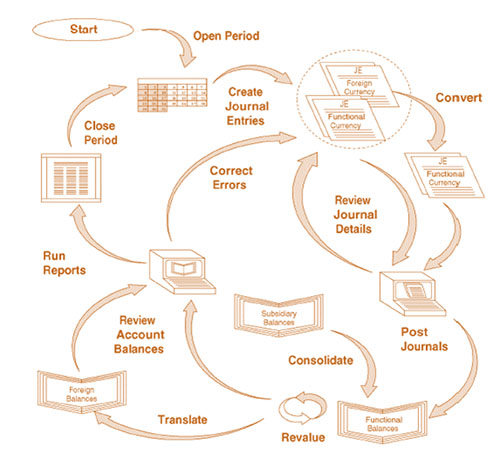
GAAP requires that long-lived assets, such as buildings, furniture and equipment, be valued at historic cost and depreciated appropriately. Under IFRS, these same assets are initially valued at cost, but can later be revalued up or down to market value. Any separate components of an asset with different useful lives are required to be depreciated separately under IFRS. That’s because, for the most part, your management reports are used internally, for everything from day-to-day operations to Board of Directors reporting. You’re able to report in a way that best meets your business needs and aligns with the external explanations of how your business runs.
In the United States, financial reporting practices are set forth by the Financial Accounting Standards Board (FASB) and organized within the framework of the generally accepted accounting principles (GAAP). Generally accepted accounting principles refer to a common set of accepted accounting principles, standards, and procedures that companies and their accountants must follow when they compile their financial statements. What are the requirements of the IFRS for the statement of retained earnings? The IAS 1 sets out the overall requirements for financial statements, including how the statements should be structured, the minimum requirements for their content, and overriding concepts. Hence, IAS 1 (IFRS) requires a company or business to present a separate statement of retained earnings (statement of changes in equity SOCE) as one of the components of financial statements.
- Consequently, the theoretical framework and principles of the IFRS leave more room for interpretation and may often require lengthy disclosures on financial statements.
- The purpose of GAAP is to help investors analyze financial data and compare different companies to make informed financial decisions.
- However, IFRS gives organizations the flexibility to classify costs as capitalized and amortized over time.
- The IFRS position may be too aggressive, allowing for the deferment of costs that should have been charged to expense at once.
- These accounting standards are dictated by the International Accounting Standards Board (IASB) which are adhered to by many countries outside the US.
In order to present a fair depiction of the business conducted, publicly-traded companies are required to follow specific accounting guidelines when reporting their performance in financial filings. The two main sets of accounting standards followed by businesses are GAAP and IFRS. If you want to further your accounting knowledge, it’s critical to understand the standards that guide how companies record transactions and report finances.
Roadmap: Current Expected Credit Losses (
The IFRS is more vibrant and constantly revised in response to an ever-changing financial environment. A key may be that the IFRS should agree to take some FASB standards to accommodate the needs of the U.S. constituents and stakeholders. Stock markets will see a decrease in the prices that go with entering foreign exchanges, and all markets obeying the same rules and standards will further permit markets to contest internationally for global investment prospects.
IFRS is principles based, so that general guidelines are set forth, and users are expected to use their best judgment in following the principles. The following discussion highlights specific differences between the two sets of standards that may be useful to users of financial statements. While the approaches under GAAP and IFRS share a common framework, there are a few notable differences. IFRS has a de minimums’ exception, which allows lessees to exclude leases for low-valued assets, while GAAP has no such exception. The IFRS standard includes leases for some kinds of intangible assets, while GAAP categorically excludes leases of all intangible assets from the scope of the lease accounting standard.
- For example, the recent GAAP standard for revenue from contracts with customers, Auditing Standards and the corresponding IFRS standard, IFRS 15, share a common principles-based approach.
- This equation is necessary when calculating a company’s Profit Before Tax which is used in the Cash flow statement under Operating activities when using the indirect method.
- Also, we can see that in accordance with the IFRS, Tesco’s total comprehensive income, owners’ investments, dividends, and treasury share transactions are contained in its statement of changes in equity.
One of the key differences between these two accounting standards is the accounting method for inventory costs. Under IFRS, the LIFO (Last in First out) method of calculating inventory is not allowed. Under the GAAP, either the LIFO or FIFO (First in First out) method can be used to estimate inventory.
Discounted Cash Flow (DCF)
Modifying and merging the recent standards with internationally accepted ones will force accounting professionals to learn the new standard, leading to steadiness in accounting practices. The procedure will offer more reliable information and will be abridged without the necessity for change to the standards of the country. Aditi Malhotra is a Content Marketing Manager and a tech enthusiast with a keen interest in the SaaS industry. With over a decade of experience, she writes insightful and informative content on how SaaS is transforming the future of work.
IFRS S1 and IFRS S2 in the UK – economia
IFRS S1 and IFRS S2 in the UK.
Posted: Mon, 07 Aug 2023 15:27:24 GMT [source]
The main difference between IFRS and US GAAP is that GAAP is rule-based, while IFRS is principle-based. The difference mainly lies in the methodology used to evaluate an accounting treatment. Under GAAP, the research focuses more on the literature, while under IFRS the “facts pattern” is rigorously reviewed. One of the primary reasons the US does not use IFRS is because the Securities and Exchange Commission (SEC) doesn’t support that standard.
Finding the Right Balance
And since your audience is also internal, you can organize your information around them. This means you can include forecasting or predictive data, segment down to different parts of the business or departments and incorporate an operational view for a fuller, more integrated, picture of your business. And while financial reporting can offer internal insights of its own, it’s the information in your management reports that will drive your organizational decisions and help you see whether you’re meeting your business goals.
GAAP divides owners’ accounts into two categories such as contributed capital and retained earnings whereas IFRS divides owner’s accounts using three categories such as share capital, accumulated profits and losses, and reserves. The first two IFRS categories (share capital and accumulated profits & losses) correspond to the two categories used under U.S. 108- In paragraph 106, the components of equity include, for example, each class of contributed equity, the accumulated balance of each class of other comprehensive income and retained earnings. Although the merging efforts were on financial performance reporting, the main problems are the difference in the U.S.
What Is the Difference Between the IASB and FASB?
We can see the use of the IFRS terminologies as discussed earlier such as share capital, share premium, retained earnings, etc. Also, we can see that in accordance with the IFRS, Tesco’s total comprehensive income, owners’ investments, dividends, and treasury share transactions are contained in its statement of changes in equity. In addition, we can also notice the use of the ‘Reserves’ category on Tesco’s statement which is not used in the GAAP statement of retained earnings. One of the ways the SEC has pursued these goals is by upholding the domestic quality of financial reporting and encouraging the convergence of the U.S. and IFRS standards.
GAAP requires financial statements to include a balance sheet, income statement, statement of comprehensive income, changes in equity, cash flow statement, and footnotes. It is recommended that the balance sheet separates current and noncurrent assets and liabilities, and deferred taxes are included with assets and liabilities. Therefore, a statement of retained earnings is a financial statement that shows the changes in a company’s retained earnings over a period of time. A company’s retained earnings are the portion of its profits that are not paid out as dividends but are rather reinvested back into the company’s business. In accordance with the GAAP or IFRS statement of retained earnings requirements, the retained earnings statement can be prepared together with the income statement or the balance sheet or as a separate financial statement. Both standards use statements of cash flows, balance sheets, and income statements.

They are obligated to adopt and follow GAAP standards for accounting and financial reporting. Organizations with foreign SEC registrants can, however, use IFRS; over 500 such companies in the US use IFRS standards. GAAP standards require organizations to write down the market value of their fixed or inventory assets, and this write-down amount cannot be reversed even if the asset’s market value increases over time.
Financial reporting standards and requirements differ by country, which makes variations in financial reporting. The convergence of GAAP and IFRS, though a complex and challenging task, could yield numerous benefits. For businesses, convergence could reduce the complexity and costs of financial reporting, particularly for those operating internationally.
Cannabis Company Financial Reports Don’t Impress – New Cannabis Ventures
Cannabis Company Financial Reports Don’t Impress.
Posted: Sun, 20 Aug 2023 17:23:00 GMT [source]
However, GAAP also allows the Last In, First Out (LIFO) method, which is not allowed under IFRS. Using the LIFO method may result in artificially low net income IFRS Vs GAAP and may not reflect the actual flow of inventory items through a company. GAAP tends to be more rules-based, while IFRS tends to be more principles-based.
Qualifying contingent liabilities are recorded as an expense on the income statement and a liability on the balance sheet. GAAP addresses such things as revenue recognition, balance sheet, item classification, and outstanding share measurements. If a financial statement is not prepared using GAAP, investors should be cautious. Also, some companies may use both GAAP- and non-GAAP-compliant measures when reporting financial results. GAAP regulations require that non-GAAP measures are identified in financial statements and other public disclosures, such as press releases. A statement of retained earnings is used to show how much net profit or net income an organization has earned during a certain period of time, usually a quarter or a year.
The Securities and Exchange Commission (SEC) has openly expressed a desire to switch from GAAP to IFRS, though this development has been slow. However, deciding which set of standards to use when making financial reports like the statement of retained earnings would depend on whether the company operates in the US or internationally. The IFRS vs US GAAP refers to two accounting standards and principles adhered to by countries in the world in relation to financial reporting. More than 110 countries follow the International Financial Reporting Standards (IFRS), which encourages uniformity in preparing financial statements.
The following differences outlined in this section affect what financial information is presented, how it is presented, and where it is presented. US GAAP defines an asset as a future economic benefit, while under IFRS, an asset is a resource from which economic benefit is expected to flow. What follows is an overview of the differences between the accounting frameworks used by GAAP and IFRS. This is at a broad, framework level; differences in accounting treatments for individual cases may also be added as this gets updated. The focus of this publication is primarily on recognition, measurement and presentation.
Under IFRS, the first in, first out (FIFO) inventory valuation method is encouraged. By contrast, GAAP allows the use of the LIFO inventory method, which means that companies using GAAP may end up valuing their inventory differently than businesses using IFRS. However, a Canadian organization also filing in the United States is permitted to use US GAAP. Further, if a foreign company in Canada is a US SEC issuer, it may use US GAAP.
